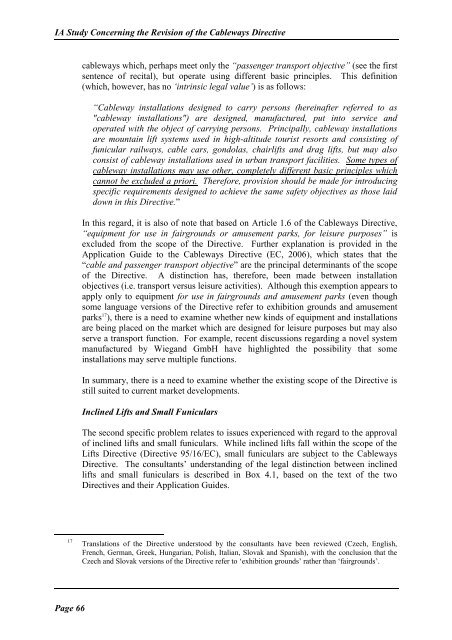Cableways Impact Assessment Study - Final Report - saferail.nl
Cableways Impact Assessment Study - Final Report - saferail.nl
Cableways Impact Assessment Study - Final Report - saferail.nl
You also want an ePaper? Increase the reach of your titles
YUMPU automatically turns print PDFs into web optimized ePapers that Google loves.
IA <strong>Study</strong> Concerning the Revision of the <strong>Cableways</strong> Directive<br />
cableways which, perhaps meet o<strong>nl</strong>y the “passenger transport objective” (see the first<br />
sentence of recital), but operate using different basic principles. This definition<br />
(which, however, has no ‘intrinsic legal value’) is as follows:<br />
“Cableway installations designed to carry persons (hereinafter referred to as<br />
"cableway installations") are designed, manufactured, put into service and<br />
operated with the object of carrying persons. Principally, cableway installations<br />
are mountain lift systems used in high-altitude tourist resorts and consisting of<br />
funicular railways, cable cars, gondolas, chairlifts and drag lifts, but may also<br />
consist of cableway installations used in urban transport facilities. Some types of<br />
cableway installations may use other, completely different basic principles which<br />
cannot be excluded a priori. Therefore, provision should be made for introducing<br />
specific requirements designed to achieve the same safety objectives as those laid<br />
down in this Directive.”<br />
In this regard, it is also of note that based on Article 1.6 of the <strong>Cableways</strong> Directive,<br />
“equipment for use in fairgrounds or amusement parks, for leisure purposes” is<br />
excluded from the scope of the Directive. Further explanation is provided in the<br />
Application Guide to the <strong>Cableways</strong> Directive (EC, 2006), which states that the<br />
“cable and passenger transport objective” are the principal determinants of the scope<br />
of the Directive. A distinction has, therefore, been made between installation<br />
objectives (i.e. transport versus leisure activities). Although this exemption appears to<br />
apply o<strong>nl</strong>y to equipment for use in fairgrounds and amusement parks (even though<br />
some language versions of the Directive refer to exhibition grounds and amusement<br />
parks 17 ), there is a need to examine whether new kinds of equipment and installations<br />
are being placed on the market which are designed for leisure purposes but may also<br />
serve a transport function. For example, recent discussions regarding a novel system<br />
manufactured by Wiegand GmbH have highlighted the possibility that some<br />
installations may serve multiple functions.<br />
In summary, there is a need to examine whether the existing scope of the Directive is<br />
still suited to current market developments.<br />
Inclined Lifts and Small Funiculars<br />
The second specific problem relates to issues experienced with regard to the approval<br />
of inclined lifts and small funiculars. While inclined lifts fall within the scope of the<br />
Lifts Directive (Directive 95/16/EC), small funiculars are subject to the <strong>Cableways</strong><br />
Directive. The consultants’ understanding of the legal distinction between inclined<br />
lifts and small funiculars is described in Box 4.1, based on the text of the two<br />
Directives and their Application Guides.<br />
17<br />
Translations of the Directive understood by the consultants have been reviewed (Czech, English,<br />
French, German, Greek, Hungarian, Polish, Italian, Slovak and Spanish), with the conclusion that the<br />
Czech and Slovak versions of the Directive refer to ‘exhibition grounds’ rather than ‘fairgrounds’.<br />
Page 66
















